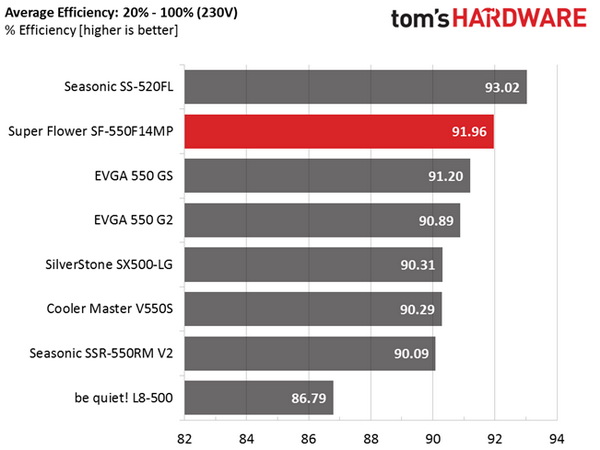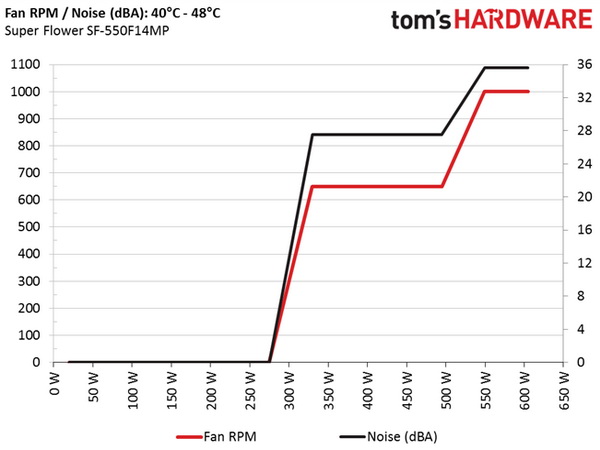Super Flower Leadex Platinum 550W PSU Review
Super Flower responds to the high demand for low-capacity and highly efficient PSUs with the release of its Leadex Platinum with 550 W max power. This unit packs high performance, silent operation and Platinum efficiency.
Why you can trust Tom's Hardware
Efficiency, Temperature And Noise
Efficiency
Our efficiency testing procedure is detailed here.
Using the results from the previous page, we plotted a chart showing the SF-550F14MP efficiency at low loads, and loads from 10 to 110 percent of the PSU's maximum-rated capacity.




This PSU is among the most efficient we have tested in this category, losing only to the SS-520 FL, which uses Seasonic's high-end platform. Compared with the Leadex Gold platform (EVGA 550 G2), the Platinum Leadex has 1 percent more efficiency at normal loads and around 1.8 percent more at light loads, which is quite a difference.
Efficiency At Low Loads
In the following tests, we measure the efficiency of the SF-550F14MP at loads significantly lower than 10 percent of the device's maximum capacity (the lowest load the 80 Plus standard measures). The loads we dialed were 20, 40, 60 and 80W. This is important for representing when a PC is idle, with power-saving features turned on.
| Test # | 12V | 5V | 3.3V | 5 VSB | Power(DC/AC) | Efficiency | Fan Speed | Fan Noise | PF/AC Volts |
|---|---|---|---|---|---|---|---|---|---|
| 1 | 1.192A | 0.491A | 0.481A | 0.194A | 19.64W | 75.45% | 0 RPM | 0 dBA | 0.818 |
| 12.229V | 5.055V | 3.304V | 5.118V | 26.03W | 115.1V | ||||
| 2 | 2.409A | 0.983A | 0.998A | 0.390A | 39.71W | 83.79% | 0 RPM | 0 dBA | 0.906 |
| 12.229V | 5.052V | 3.302V | 5.108V | 47.39W | 115.1V | ||||
| 3 | 3.632A | 1.476A | 1.514A | 0.585A | 59.84W | 87.60% | 0 RPM | 0 dBA | 0.956 |
| 12.228V | 5.049V | 3.299V | 5.098V | 68.31W | 115.1V | ||||
| 4 | 4.839A | 1.985A | 1.999A | 0.785A | 79.77W | 88.56% | 0 RPM | 0 dBA | 0.957 |
| 12.227V | 5.047V | 3.297V | 5.088V | 90.07W | 115.1V |
At low loads efficiency was very high and in three out of the four tests we conducted, the PSU easily passed the 80 percent mark. Even with 20 W load, the PSU's efficiency exceeded 75 percent. This is one of the most significant advantages of low-capacity PSUs compared with higher capacity units. A low capacity unit is able to achieve very high efficiency levels at light loads, which in many cases will put a mid- to high-capacity PSU to shame.
5VSB Efficiency
The ATX specification states that 5VSB standby supply efficiency should be as high as possible, recommending 50 percent or higher efficiency with 100mA of load, 60 percent or higher with 250mA of load and 70 percent or higher with 1A or more of load.
We will take four measurements: one each at 100, 250 and 1000mA, and one with the full load the 5VSB rail can handle.
Get Tom's Hardware's best news and in-depth reviews, straight to your inbox.
| Test # | 5VSB | Power (DC/AC) | Efficiency | PF/AC Volts |
|---|---|---|---|---|
| 1 | 0.101A | 0.52W | 72.22% | 0.107 |
| 5.124V | 0.72W | 115.1V | ||
| 2 | 0.251A | 1.28W | 76.19% | 0.209 |
| 5.119V | 1.68W | 115.1V | ||
| 3 | 1.002A | 5.10W | 79.07% | 0.373 |
| 5.093V | 6.45W | 115.1V | ||
| 4 | 2.501A | 12.58W | 78.19% | 0.451 |
| 5.030V | 16.09W | 115.1V |


We weren't satisfied with the efficiency of the 5VSB rail; in a Platinum unit we expected to see at least one test with the efficiency reading exceeding 80 percent.
Power Consumption In Idle And Standby
| Mode | 12V | 5V | 3.3V | 5VSB | Power (AC) | PF/AC Volts |
|---|---|---|---|---|---|---|
| Idle | 12.249V | 5.058V | 3.305V | 5.126V | 5.26W | 0.491 |
| 115.1V | ||||||
| Standby | 0.10W | 0.016 | ||||
| 115.1V |


In the table above, you'll find the power consumption and voltage values of all rails (except -12V) when the PSU is idle (powered on, but without any load on its rails), and the power consumption when the PSU is in standby mode (without any load, at 5VSB).
Vampire power was very low, especially with 115V input.
Fan RPM, Delta Temperature And Output Noise
Our mixed noise testing is described in detail here.
The first chart below illustrates the cooling fan's speed (RPMs), and the delta between input and output temperature. The results were obtained at 40 C (104 F) to 48 C (118.4 F) ambient temperature.
The next chart shows the cooling fan's speed (RPMs) and output noise. We measured acoustics from 1 meter away, inside a small, custom-made anechoic chamber with internals covered in soundproofing material (be quiet! Noise Absorber kit). Background noise inside the anechoic chamber was below 18 dB(A) during testing, and the results were obtained with the PSU operating at 40 C (104 F) to 48 C (118.4 F) ambient temperature.


The following graph illustrates the fan's output noise over the entire operating range of the PSU. The same conditions of the above graph apply to our measurements, although the ambient temperature was between 28 C (82.4 F) and 30 C (86 F).
As you can see from the graph above, this is a dead-silent PSU — with the semi-passive mode selected it makes no noise at all with up to 300 W to 350 W loads. If you don't have the money to buy a pure passive PSU for zero noise output under all conditions, then this is your best alternative.
Current page: Efficiency, Temperature And Noise
Prev Page Load Regulation, Hold-Up Time And Inrush Current Next Page Cross-Load Tests And Infrared Images
Aris Mpitziopoulos is a contributing editor at Tom's Hardware, covering PSUs.
-
laviniuc you mean P2, right?Reply
"This means that we will most likely see an EVGA SuperNOVA 550 T2 unit in the near future." -
envy14tpe The 650W version sells for $85usd (here in Taiwan) and 750W for $100. Not sure why this company doesn't sell more internationally since it is at the top tier. As it is known for quality. Gonna be picking up a SuperFlower PSU with my next build.Reply -
casey_souder Replyactually it did and still says that 10C is 50F.
A change of 1 degree C equals a 1.8 degree F change. Google is doing a temperature conversion, not a unit conversion. -
Roj Number 1 Yes, 10C = 50F, but a 10C increase in temperature is a 18F increase in temp. Two different things.Reply
